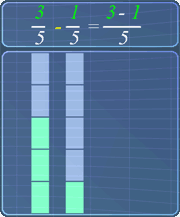Subtracting Fractions
Lesson Objective
In this lesson, we will learn about subtracting fractions. Here, we will be using some examples to explain this lesson.
About This Lesson
The basic idea behind subtracting fractions is the same as adding fractions. So, once you know how to add fractions, it is very easy to subtract fractions.
In this lesson, we will learn how to subtract fractions that involve:
- proper fractions with like denominators
- proper fractions with unlike denominators
- proper and mixed fractions with unlike denominators
The study tips and math video below explain more.

Study Tips
Tip #1
The adding fractions lesson covered the basics that you need to know. Feel free to go through that lesson if you are not sure how to add fractions.
Math Video
Lesson Video
Sponsored Links
Subtracting Fractions from MathExpression.com on Vimeo.
| |

Please support us by downloading our Fraction Basics app and subscribe to get all 12 video lessons and All Access pass to 8 Zapzapmath Home apps with 180 math games from as low as US$1.67/month:
Apple App Store (iOS) |
Google Play (Android)
Math Video Transcript
00:00:03.030
In this lesson, we will learn about subtracting fractions.
00:00:07.110
Now, the idea behind subtracting fraction is similar to adding fraction.
00:00:13.070
To recall, let's add 3/5, with 1/5.
00:00:18.180
Now, we know that, since the fractions have like denominators, we can just add the numerators together, and keep the denominator the same.
00:00:28.200
Hence, we get 3 plus 1,/5.
00:00:33.150
From this observation, we can see that, when we subtract the fractions, 3/5 with 1/5, we just need to subtract the numerators, and keep the denominators the same.
00:00:47.110
Hence, we get 3 minus 1/5.
00:00:52.110
Next, subtract 3 with 1. This gives 2. Finally, we get the fraction, 2/5.
00:01:02.240
Alright, let's visually see how subtracting fractions work. We can see that, by subtracting these 3 green parts with this 1 green part, we get 2 green parts.
00:01:15.220
The 2 green parts represent the numerator 2, and all the 5 parts in this bar represent the denominator 5.
00:01:26.110
Next example, let's subtract, 1/3, with 2/9.
00:01:32.070
Notice that, these 2 fractions have unlike denominators. This means that, the size of these parts are not the same, as you can see here.
00:01:44.060
Because of this, we can visually see that, we cannot subtract these two fractions as they are.
00:01:51.120
Therefore, the only way to subtract these fractions, is to make all the parts to have the same size. This means that, these fractions must have like denominators.
00:02:03.090
To do so, we need to use Equivalent Fractions.
00:02:08.080
Now, using Equivalent Fractions, we can change this denominator to 9, by multiplying both the numerator and denominator of this fraction with 3.
00:02:18.090
This gives the fraction, 3/9.
00:02:22.230
Now, these fractions have like denominators. This means that, all the parts will have the same size. As you can see right here.
00:02:34.240
With this, we can now subtract these two fractions just like the previous example. By doing so, we get, 3 minus 2/9.
00:02:46.240
Minus 3 with 2. This gives 1. Finally, we have the fraction, 1/9.
00:02:57.130
Next example, let's subtract, 1/3 with 1 1/2.
00:03:04.020
Notice that, this fraction is a mixed fraction. To minimize mistakes, it is advisable to convert it to an improper fraction.
00:03:13.000
Note that, when doing the conversion, we just need to focus on this mixed fraction, and ignore this minus sign. Now, we multiply 2 with 1. This gives 2.
00:03:28.200
Next, we add 2 with 1. This gives 3, which becomes the improper fraction's numerator. Now, we have the improper fraction, 3/2.
00:03:43.000
Notice that, we cannot subtract these 2 fractions because they have unlike denominators.
00:03:49.190
Therefore, the only way to subtract these fractions, is to make them to have like denominators. We can do so, by using equivalent fractions.
00:04:01.240
Here's how. We can make the denominators the same by multiplying the numerator and denominator of 1/3, with the other fraction's denominator 2, and by multiplying the numerator and denominator of 3/2, with the other fraction's denominator 3.
00:04:20.020
Let's do so. Multiplying 1/3 with 2, and multiplying 3/2 with 3. This gives the equivalent fractions, 2/6, and 9/6 respectively. The denominators are now the same.
00:04:33.180
Now, we subtract these two fractions. This gives 2 minus 9/6.
00:04:46.070
Subtracting 2 with 9, gives negative 7.
00:04:50.210
Notice the negative sign here? We can rewrite it this way so that it looks neater. With this, we have the fraction, negative 7/6.
00:05:01.200
Notice that, negative 7/6 is an improper fraction. So, rather than leaving the answer like this, it is recommended to change it to a mixed fraction, using long division.
00:05:14.080
Now, when doing the conversion, we just need to focus on this fraction, and ignore this sign.
00:05:22.040
Let's start. 7/6 is the same as 7 divides 6. Now, this division gives the quotient as 1. This quotient is actually the whole number for the mixed fraction.
00:05:37.130
Next, we multiply 1 with 6. This gives 6. 7 minus 6 gives the remainder as 1.
00:05:47.200
This remainder, 1, is actually the mixed fraction's numerator.
00:05:54.240
So here, we have the final answer as, negative 1 1/6.
00:06:03.160
That is all for this lesson. Try out the practice question to test your understanding.
Practice Questions & More
Multiple Choice Questions (MCQ)
Now, let's try some MCQ questions to understand this lesson better.
You can start by going through the series of questions on subtracting fractions or pick your choice of question below.
- Question 1 on subtracting fractions with like denominators
- Question 2 on subtracting fractions with unlike denominators
Site-Search and Q&A Library
Please feel free to visit the Q&A Library. You can read the Q&As listed in any of the available categories such as Algebra, Graphs, Exponents and more. Also, you can submit math question, share or give comments there.


